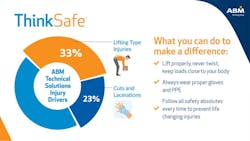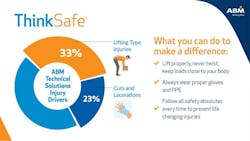The trend is easy to spot — it’s just not one most of us want to see. Control of hazardous energy is the fifth most cited OSHA violation for fiscal year 2018, and it’s held that spot for several years now. That trend goes all the way back to 2013, when Electrical – Wiring Methods was fifth most cited and Lockout/Tagout (LOTO) was eighth. That’s a persistent symptom of serious risk in the workplace.
The current dip in violations for 2018 doesn’t promise much, given the rise since 2014. Combine that with the fact that LOTO holds the No. 2 spot for OSHA’s Willful Violations, and we should be asking ourselves: How can we beat this stubborn trend, and make our workplaces safer?
The No. 1 No-No in LOTO
The No. 1 cited violation under the Control of Hazardous Energy group is 1910.14(c)(4)(i), and that matches what our technicians are seeing in the field: a dangerous lack of documentation.
Per 1910.147(c)(4)(i), “Procedures shall be developed, documented, and used for the control of potentially hazardous energy when employees are engaged in the activities covered by this section.”
Each piece of equipment is supposed to have a specific procedure written for LOTO. Without it, you’re relying on people’s memory to hold vital institutional knowledge about the facility. What the next friendly technician doesn’t know about your equipment can hurt them ― and you.
It’s not enough to have a general procedure, and it’s not enough to have specific procedures that live only in your team’s heads. They must be documented. For manufacturing facilities especially, our people in the field are finding a lack of specific written procedures. ABM power experts have begun testing a mobile resource for supplying equipment-specific procedures if they’re lacking on-site, but that’s no substitute for accurate, on-site information ― and that doesn’t satisfy OSHA’s requirement for the facility owner or operator.
Do it, and review it
The second highest count of OSHA violations for control of hazardous energy is not reviewing the written procedures annually. Once your LOTO procedures are done and documented, make sure to schedule your yearly review.
For a large facility with multiple pieces of equipment, this can feel like a huge chore that steals focus from team priorities. Check with your facility service partner’s electrical power experts to keep things flowing for you.
Do you have enough locks?
We’re also finding that facilities often don’t have enough equipment on hand for a proper LOTO program. Look ahead to the LOTO procedures you’re expecting (another reason for documentation, right?), and analyze what you’ll need. Check and make sure the equipment you have is the appropriate type and size — and that you have enough of each kind on hand to complete the procedure.
Looking ahead to 2020
To do so requires a look back to 2015, when the National Fire Protection Association (NFPA) updated rules for incident energy studies, or arc flash studies, including the requirement to review or update them ― at minimum ― every five years or whenever major changes are made to your electrical system (NFPA 70E Sec. 130.5). If you did an arc flash study when the rules updated in 2015 and haven’t done one since, it’s crucial to schedule an updated study by 2020.
If your facility doesn’t have an arc flash study, you’re not the only one carrying that risk. Off the cuff, based solely on what our teams see in the field report, we estimate that up to 80% of facilities don’t have a current and up-to-date arc flash study. Why is that number so high when compliance requires the study, especially when the cost of incident, in medical expenses alone, can run into the millions of dollars? In our experience, many owners feel it doesn’t apply to them because they don’t have specialized power distribution equipment or a lot of it.
But it does apply. It doesn’t matter if your equipment feeds rows of heavy industrial equipment or a small strip mall. NFPA 70E Sec. 130.5 says building owners are responsible.
Some facilities don’t want to pay for an arc flash study, or keep putting it off, hoping the numbers will look better next month. But lack of compliance will be Exhibit No. 1 in any suit stemming from an incident.
A positive trend in PPE
Just a few years ago, a piece of personal protective equipment (PPE) would be 8- or 10-ounce material. Today, you can get the same level of protection from an item that’s only 5-ounce material. It’s also more comfortable to wear. Comfort is no small issue with cumbersome PPE ― a super thick suit can slow down your operation, or worse, encourage someone to work without it. This is especially true if you perform work in hot environments.
Following up on the need for documenting safety above: When ensuring your PPE is properly inspected and tested, document it. Make sure it’s properly rated, inspected, tested, and written down. If you don’t know when a piece of PPE went into service — or when it was last cleared for service — you won’t know when it should come out of rotation or when it needs to be replaced.
On the horizon
Another positive trend worth noting is the increased attention on all forms of hazardous energy in a system. Proper LOTO of every piece of power distribution equipment doesn’t mean all hazardous energy is accounted for: A system can store energy in other ways, and unforeseen release of mechanical energy can be especially dangerous to workers.
One source of energy we’re seeing more attention on is fans. Just because the power is off doesn’t mean a fan won’t move. In fact, fans can easily be affected by differences in air pressure. Air drawn over a pipe can create a backdraft that will start a fan moving, and now there’s kinetic energy in the system that should be blocked.
It’s time to fight the trend
If you need help creating written procedures for LOTO, or in complying with the requirements for an up-to-date arc flash study, reach out to your facility solutions partner. They’ll be able to supply you with the expertise needed to cost-effectively comply and ensure a safe working environment.
Truettner is an environmental, health & safety manager with ABM Industries. He can be reached at [email protected].
About the Author
Tod Truettner
Environmental, Health & Safety Manager
Truettner is an environmental, health & safety manager with ABM Industries. He can be reached at [email protected].

